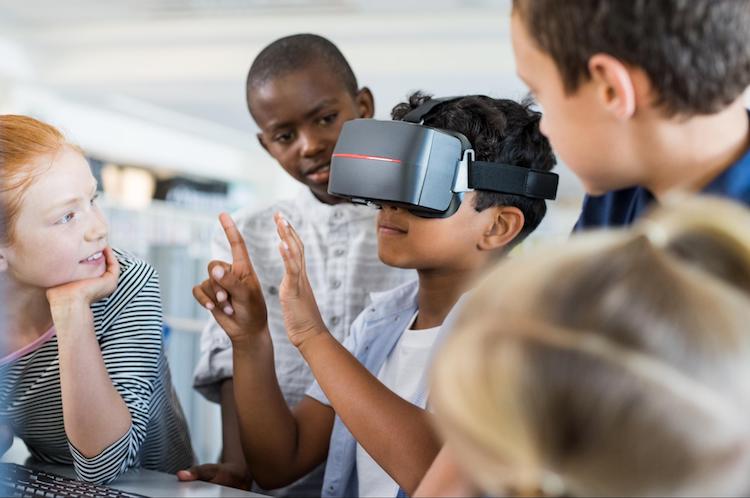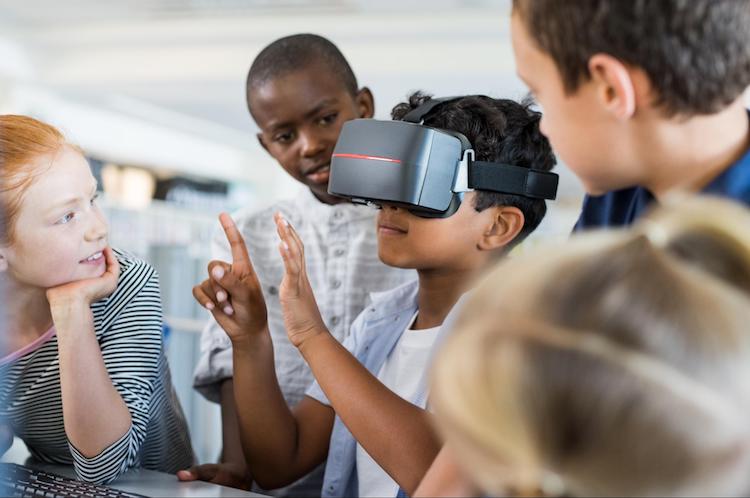Future Education Technology: How Digital Trends Are Shaping Teaching

Technology has rapidly changed every facet of our society, including the education industry. Today students grow up with internet-connected devices at home and in the classroom, which changes the way they learn. Future education technology will transform learning by giving teachers and students a variety of new tools to work with.

While the future of education will be driven in large part by technology, ensuring the new teaching tools are put to use most effectively requires a new generation of educators who appreciate the importance of human interaction in educational settings. A liberal studies degree from Maryville University can lead to a rewarding and exciting career in secondary education. Students pursuing this path need to gain the knowledge and skills that will let them apply new education technologies to maximize their benefits for middle school and high school students today and tomorrow.
Tablets in Classrooms
Tablets have become the mobile device that students use most often, and for good reason — they’re small and portable enough for students to use individually, big enough for multiple students to share, and versatile enough to serve as a video player, word processor, or educational gaming device. According to a 2015 Pearson Education study of more than 2,000 students in fourth through 12th grades, 78% of elementary school students utilized tablets in their schoolwork in 2014. That’s a jump of 12% from the year prior. Use of tablets by middle school students increased from 58% to 69% from 2014 to 2015, while tablet use among high school students rose from 42% to 49% year to year. The same Pearson study of education trends found that nine in 10 students believe tablets “will change the way students learn in the future.” The next generation of instructors would be wise to consider ways to implement tablets in their curriculum, whether for giving students assignments, sharing multimedia, or any number of other uses for the devices.
Ample opportunities for the creative application of tablets exist for teachers who have earned a liberal arts degree and chosen to join the field of education. The Association for Supervision and Curriculum Development (ASCD) notes that “changing classroom practice with technology is really, really hard” — a reflection on the fact that tablets are most often used to update existing education practices, such as distributing materials and taking notes, rather than for newer, innovative purposes. The next generation of teachers who embrace tablets will have a profound impact on their students, teaching them greater technological literacy and expanding their opportunities to learn in fresh ways. In this regard, the answer to the question, “Is teaching a good career for the future?” is a resounding “Yes!”
Assistive Technology
For students with disabilities, new technologies mean empowerment, putting them on a more equal footing with their classmates than ever before. According to the National Center for Education Statistics (NCES), just under 7 million students in the U.S. — or about 13% of total public school enrollment — receive special education services. A range of assistive technology devices are available for special education students and students with disabilities to provide the educational support they need.
One important education trend in the category of assistive technology devices is the use of alternative input devices. These allow students with disabilities to use computers and tablets equipped with modified keyboards featuring larger buttons, cursors they can manipulate with their mouth or feet, and other capabilities. For students whose disability prevents them from using any sort of manual input device, speech-to-text technology has become a reliable alternative. Additionally, more subtle technology advances, such as easy-to-read fonts that make it easier for students with dyslexia, support those with minor learning disabilities.
These trends in future education technology break down the barriers separating students based on their ability to learn. Teachers who leverage these and other innovations will be on the forefront of education leadership.
Augmented Reality/Virtual Reality and Voice Platforms
Education trends will ride the wave of increased internet capabilities and higher network bandwidth, bringing advanced technology into schools with greater ease. Two of the major areas of next-wave technology are augmented reality and virtual reality (AR/VR). Augmented reality devices enhance real-world materials, such as making a map jump off a page, while virtual reality products create an immersive digital world in which students interact in virtual 3D worlds that enhance learning experiences.
Google has already made its first inroads into AR/VR, releasing a cardboard VR viewer that costs as little as $15. The viewer is part of Google’s Expeditions app and platform released in 2017. AR/VR learning is particularly well suited to students in STEM fields, giving teachers access to virtual dissection, the exploration of microscopic organisms up close, and many other educational applications. But that’s not all — AR/VR technology also allows students to circumnavigate the globe and explore historically important moments up close and personal, traveling the universe without ever leaving the classroom.
Meanwhile, voice platforms such as Google Echo and Amazon Alexa, which are proliferating in homes across the country, also have classroom applications. These products provide students with instant answers. They can also be used to play educational games, conduct polls of their classmates, and chat with students across the world, among many other capabilities.
Learn More
The steady pace of technological advances in education are trending to help make teaching a career with an excellent future. A strong liberal arts background can provide a firm foundation for students interested in pursuing a career in education. While additional study and credentials may be necessary, a degree in liberal arts helps provide future teachers with subject-area expertise. Additionally, the online degree programs offered by Maryville University can provide an added layer of personal perspective for how students and teachers can leverage technology in education. With many secondary schools looking to hire teachers who specialize in particular fields, a liberal arts degree from Maryville University will set you on a path toward utilizing these and other technologies in your own classroom.
Sources
Association for Supervision and Curriculum Development, “How to Transform Teaching with Tablets”
EdSurge, “3 Emerging Technologies that Will Reshape Education in 2019”
Forbes, “Top 5 Digital Transformation Trends in Education for 2019”
The Tech Edvocate, “Assistive Technology for Students with Disabilities”
MDR Education, “3 Ways Augmented Reality Is Wowing Teachers and Students”
National Center for Education Statistics, Children and Youth with Disabilities

